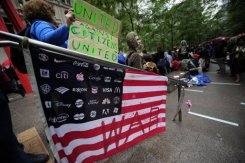 |
| “Occupy Wall Street” demonstrators stage a protest near Wall Street in New York © AFP Emmanuel Dunand |
NEW YORK (AFP) – As anti-corporate demonstrations spread across the United States, the protesters claim they are inspired by the revolutions in the Middle East, but protests over economic grievances in Europe would be a closer comparison.
When anti-capitalist activists first unfolded sleeping bags and brandished handmade placards in a small park near Wall Street two weeks ago, they said they were following the example of Egyptian protesters in Tahrir Square.
In reality, the differences outweighed any similarities: numbers of protesters were tiny compared to Cairo, no one was attempting to bring down the government, and there was zero risk of being shot by security forces.
Yet, as the Occupy Wall Street protest entered its third week Monday, it is being taken more seriously. Similar sit-in demonstrations have popped up from Boston to Chicago and Los Angeles and this week the New York protest expects to swell with support from trade unions.
So what do these would-be revolutionaries want?http://www.blogger.com/post-edit.g?blogID=7811593327276272802&postID=5058725125279611961
Ask 10 of the mostly young, often well-educated demonstrators bedding down in Manhattan’s Zuccotti Park and you might get 10 different answers.
 |
| Advertisement |
Anger over the government bailouts of big Wall Street institutions, joblessness, student debt, global warming, police brutality: these are just for a start.
Finding a leader to speak for the group is harder still.
Even one man who could be clearly seen organizing logistics in the camp refused to admit he was in a position of responsibility.
“Everyone has a different reason and goal for being here,” Anthony, 28, said.
His own, rather esoteric aim was to turn the camp around the corner from the New York Stock Exchange into permanent utopia: “a safe space autonomous from the rules from outside.”
But as their numbers grow, the US protesters could yet coalesce into something more resembling a genuine protest movement.
In Los Angeles, some 300 people have been demonstrating since Saturday. In Boston, about 100 people were camped out.
In Chicago, where some 50 people have been camped in the financial district for 11 days, grievances were as diverse as in New York, but the determination was as strong.
“It took Vietnam to get people my age into the street and we changed things. I’m seeing the same thing happening here. It always starts small, but time will tell. All great movements start from scratch,” says Eleanor Buckley, 61, who came with water and food for the mostly young protesters.
Probably the closet parallels are not in Tahrir Square but Europe, where simmering frustration and anger at the fallout from recession and financial crises have spilled onto the street.
Spain has seen mass protests dubbed the “indignant” movement against politicians’ handling of the economy. Last month, thousands of leftists demanded a referendum to be held on a plan to enshrine balanced budgets in the constitution.
Similar street demos have spread across Italy, while Greece has seen major unrest as young people and government employees facing cuts in jobs, pensions and salaries take over public buildings.
A little further away, angry crowds are challenging the government with tent cities in Israel.
Apart from heavy use of social networking sites, all the demonstrations from Los Angeles to Tel Aviv share bitterness at what is seen as the disconnect between governments and ordinary people in an era of stressed budgets and economic uncertainty.
Even the riots and looting this summer in London and elsewhere in Britain are seen as being fueled by hopelessness.
In America, similar worries are reinforced by leftists’ disillusion with President Barack Obama and anger on both sides of the political aisle at the political and business elite.
On Monday, even George Soros, one of the world’s richest men, expressed support for the protesters, saying they had been provoked by “bumper” bonuses paid by Wall Street banks.
“I think I can sympathize with their views,” he said.
The Wall Street protesters had trouble getting media coverage when they began their sit-in. Not any longer — even if their goals are still hard to define.
“It’s becoming impossible to ignore and we’re still here,” Anthony, the organizer at Zuccotti Park, said.
© AFP — Published at Activist Post with license
linkwithin_text=’Related Articles:’



Be the first to comment on "Wall Street protests spread nationwide"